How to Find Free Campsites for Car Camping & Van Life
Learn where and how to find FREE campsites on your next road trip with this list of our favorite websites, apps & maps for finding free dispersed camping.
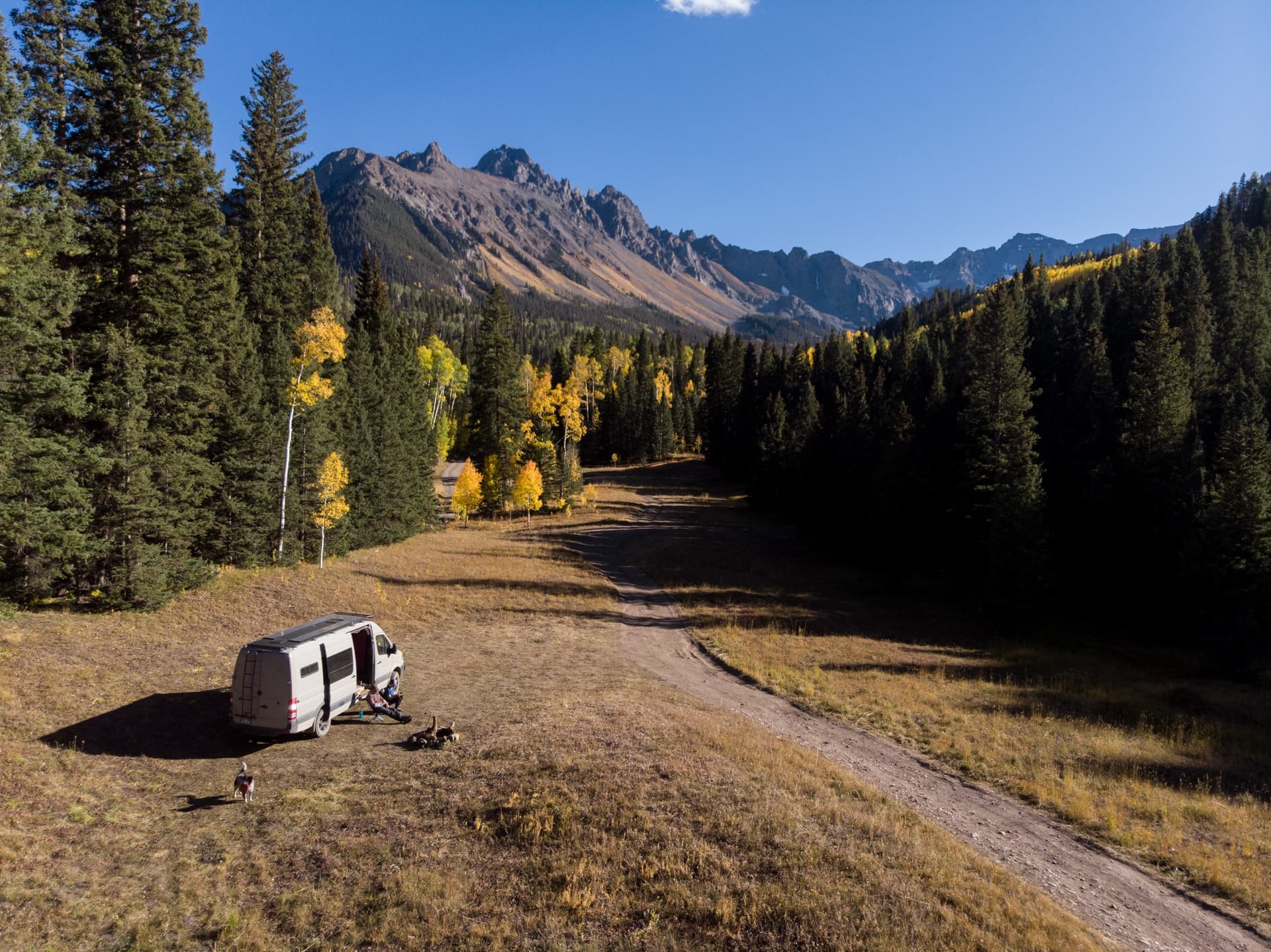
If you are planning a road trip or are a new van-lifer, you might be surprised by how much camping fees add up over time, especially if you end up staying at National Parks or privately owned campgrounds. I realized this when I got my first Sprinter Van in 2016, and I quickly learned that paying $15-50 every night for established campgrounds was not going to be an option if I wanted to be on the road long-term.
Since then, I’ve been using a variety of tools to find free campsites, also referred to as dispersed camping or boondocking. Whether you are looking for an off-the-beaten-path place to set up your tent away from crowds or are trying to stick to a budget, this blog post on how to find free camping will help you find great campsites during your road trip.
Get outside and enjoy a quiet night of camping under the stars on a budget with this guide to finding free campsites across the U.S.
#1 campsite finder app
Try The Dyrt PRO free for 30 days
Get a FREE 30-Day membership to The Dyrt PRO, one of our favorite apps for finding campsites.
Perks include:
• 5,000+ free camping locations
• 1,000+ campground discount network
• $0 extra booking fees
• Get reservations at sold-out campgrounds, and more
Use the code BEARFOOT to get 30 days free!
1-on-1 Van Life Coaching
Ready to get over your analysis paralysis and put your van life dreams into action? Let’s make it happen together. Book a 1-on-1 van life coaching call now and take the first step towards a life of adventure, freedom, and unforgettable experiences.
What Is “Free Camping”?
While most established campgrounds require a fee, free camping means you can camp for free in your car, tent, camper van, or RV. Free camping doesn’t allow for advanced reservations, and it means you’ll most likely be without amenities such as potable water, picnic tables, trash cans, showers, and toilets. You’ll need to come fully prepared with everything you need, pack everything out, and abide by Leave No Trace principles. So why would anyone want to give the comforts of an established campground? Here are some of the positive trade-offs of free camping:
- Easy way to save money
- Offers more solitude and remoteness than a traditional campground
- Sometimes you’ll have better views!
- Greater flexibility with travel plans
- Ability to make or change last-minute plans
We think the benefits of free camping well outweigh the negatives, but we know that planning a free camping trip can be a little overwhelming at first. We’re going to break down everything you need to know, starting with a few common names that are used for free camping:
Dispersed camping
This is the official free camping term used by the National Forest Service (USFS) and Bureau of Land Management (BLM), the two agencies that oversee the majority of free camping lands in the US. If you stop by a National Forest office, ranger station, or call one of these agencies, you’ll want to ask about dispersed camping options in the area.
Read next: New to camping? Read our tips on how to be a good campsite neighbor.
Boondocking
Boondocking is a blanket term for all free camping used by RVers, roadtrippers, and long-term travelers. It can be used interchangeably with any other term for free camping.
Stealth camping
Stealth camping is the act of camping in an urban area that is not primarily used for overnight camping. Residential neighborhoods, industrial areas, and big box stores like Walmart and Cracker Barrel are common places to get some shut-eye for free.
Dry camping
Dry camping refers to camping without potable water access or electrical hookups. It is interchangeable with boondocking, free camping, and dispersed camping.
Where Can You Camp For Free in the US?
Understanding different public land designations will help you find free campsites. Not all public land agencies manage dispersed camping in the same way. Some, like the National Parks, offer mostly paid campgrounds, while other agencies – like the BLM – typically have a 14-day free camping limit.
BLM, or the Bureau of Land Management, and US Forest Service land are the two types of public land where free camping is most easily found. Regulations vary by location and you’ll typically find signs at the start of the dirt road telling you how long you can stay, any fire restrictions in place, and any other important information that you’ll want to know. Any areas that are off-limits are generally marked by signs. Be sure to follow all rules and regulations and apply for a camping permit if one is required.
Bureau of Land Management (BLM)
Bureau of Land Management (BLM) land is mostly found out west, and dispersed camping is allowed on most BLM land for up to 14 days, although in popular areas that limit can be shorter – always follow posted signs.
Unfortunately, the BLM doesn’t have a comprehensive map on their website showing where all of the free BLM campsites are, but you can get a feel for what’s available in your region by browsing their regional maps found here. Some states have pretty handy guides, like Idaho, and you also contact the local BLM office to get more info on where you can camp for free. The tools and apps we talk about in the next section will also help you identify where free BLM camping is.
Forest Service Land (USFS)
Similar to BLM lands, dispersed camping is allowed in over 175 national forests and grasslands in the United States. For information on camping at USFS locations across the country, you have to check with each ranger district directly. On the USFS website, you can search by state and select a specific forest or grassland to learn more about.

While BLM and USFS land are the most common places to find dispersed camping, you may also find free campsites on state forest land, certain state parks, national recreation areas, and city parks.
Best Apps for Finding Free Campsites
There are more tools available than we list here, but after 5+ years of road tripping in my van, these are my favorite online resources and apps for finding free campsites:
The Dyrt & The Dyrt PRO
The Dyrt is currently the top-rated camping app for Apple and Android and one of our favorite tools for finding campsites. It has listings of all kinds of different campgrounds including public and private ones as well as some free dispersed camping options. Their listings include reviews, photos, information on amenities, and more.
You can also search by required amenities. Let’s say you need Wifi to get some work done or need a location with showers or even a pet-friendly location, you can narrow your search down using all types of parameters.
There is a free version, as well as a Dyrt PRO membership upgrade for $35.99/year. In my detailed review of the Dyrt PRO, I discuss the many membership benefits including:
- The ability to search for campsites and read reviews offline – no cell service or wifi needed (this is huge as not having service can be stressful if you don’t have a plan for the night).
- Map layers that tell you where BLM, Forest Service, and National Park land are located (amazing feature for finding dispersed camping!)
- A trip planning tool that allows you to build your trip before heading out and then exports it all to google maps
- You can save campgrounds you’re interested into lists so you have them handy for when you’re on the road.
- Up to 40% off camping reservations at 1,000s of campgrounds. Many of these campgrounds are in areas where free camping on public land isn’t available, and the discount alone can pay for your annual membership.
- As a PRO member, you’ll also get discounts on outdoor gear from their brand partners.
*The Dyrt is currently offering a FREE 30-day membership to The Dyrt PRO to Bearfoot Theory readers (use the code “Bearfoot” if signing up on mobile!). Try it out and see how you like it!*
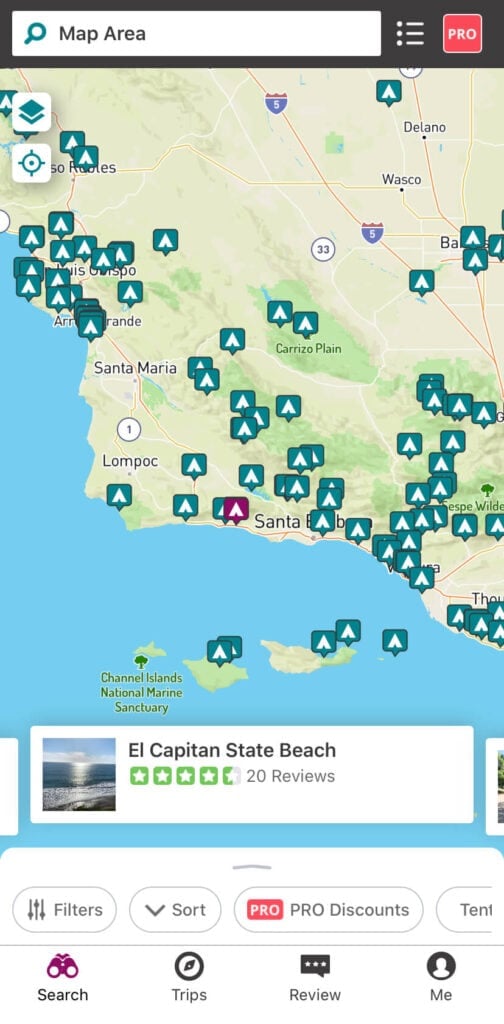
iOverlander
iOverlander is a FREE app that you download to your phone and it’s a favorite among van lifers. Users submit information about places they’ve camped, and it’s one of the most comprehensive crowdsourced databases of free camping that I’ve found that covers all of North America (including Canada and Mexico).
Users can upload photos, a description, and other information, like internet availability, along with GPS coordinates. There are also some paid campsites on iOverlander as well that you can toggle on as a layer.
Because iOverlander is crowd-sourced, the app is constantly updated with new info. Maybe a dispersed area was recently closed or perhaps someone had a sketchy encounter at a campsite. Users in iOverlander are very good at sharing important information like that in the comments section for each site – one of the unique benefits of using the iOverlander app.
More recently, they’ve added amenities like water refill and propane stations, dumps, and more. While iOverlander doesn’t officially work offline, you’ll still be able to see your location and nearby dispersed camping areas when zoomed out. You just won’t be able to see any user photos or the map background when you zoom in or be able to get directions – a feature that hopefully will improve in the future.

All Stays Camp & RV
All Stays Camp & Rv is a paid app that you download to your phone. All Stays includes paid and dispersed campsites, but for dispersed it’s not as comprehensive as the previous two apps I mentioned. What I like about All Stays is that it also has other types of places you can park for free, including Walmarts, rest-stops, and casinos, as well as other amenities. In addition, you can find places to fill up water, RV dumps, and other services that you often need on the road.
Once you find a campsite, there is a button that links to Google Images, and you can automatically open up directions in Apple or Google maps. The basic functions of the app even sort-of work when you are off-the-grid and have no cell service.
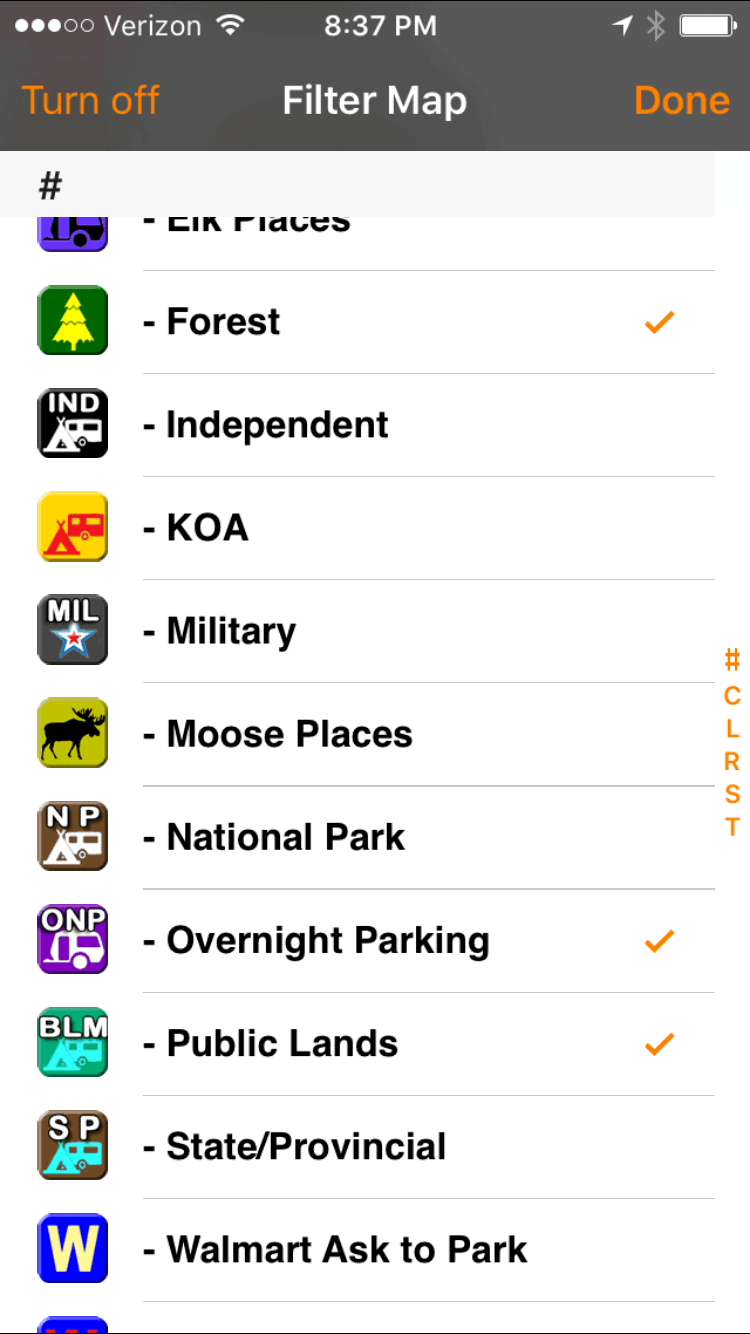
Sēkr
Sēkr (formerly known as The Van Life App) is a women-owned app built by fellow van lifers. Similar to iOverlander, Sēkr uses crowd-sourced data to provide campsite information, including reviews and photos.
Sēkr also has a “Community Calendar” where you can find upcoming van life meetups and gatherings, caravan invitations, and other opportunities to connect with other van lifers. With your Sēkr profile, you can also opt-in to see other Sēkr members in your general area and send friend requests based on shared interests.
Recently, Sēkr launched a premium version (called Sekr+) which allows users to download maps and campsite info for offline use, adds overlay map layers for US Forest Service and Bureau of Land Management land, and includes overlays of coverage maps for major US carriers like AT&T, Verizon, and T-Mobile.

FreeCampsites.net
If you don’t want to download a paid app or prefer to search on a computer or browser, Freecampsites.net is a desktop tool that allows you to zoom in on a map to locate campsites or search by zip code. Additionally, it also has a trip planning option that will allow you to create a route using free dispersed camping options. You can even search by the type of access road to the sites. When you select a site, you’ll be given the GPS coordinates, elevation, and the local weather so you can pack accordingly. I’ve found that freecampsites.net sometimes has free dispersed sites that aren’t found on iOverlander or other apps.
Campendium
Campendium is a free iPhone-only app or desktop tool that has thousands of campsites pinned from free dispersed sites to swanky RV parks. This app is tailored toward RVers who may need dispersed campsites that are larger and can be accessed with low clearance.
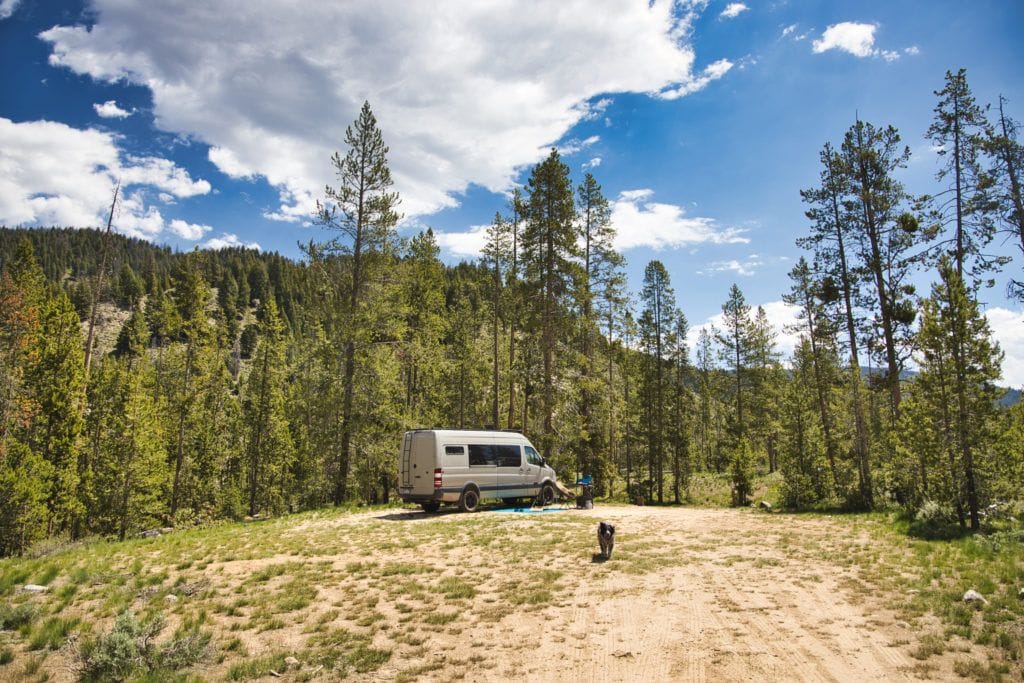
Once you’ve found a spot you want to camp using one of these apps, open up Google Maps to get directions. I like to use satellite view to zoom in to see if I can tell anything else about the campsite. For example, if there’s more than one site in the area, I’ll see if I can scope out which one is going to be the best.
If you don’t have service, you can use your paper atlas or a GPS if you have one to navigate to the campsite.
Other Tools for Finding Free Campsites
Road Atlas
A paper road atlas can be super handy when road tripping or doing van life and looking for free camping. In rural areas, google maps can be unreliable, and if your service cuts out, you’ll be happy you have an old-school paper map to navigate with.
Benchmark Road Atlases are my go-to paper maps. If I’m going to be spending any extended amount of time in one state, I will invest in a Benchmark Road Atlas. Each state has its own atlas and they generally run about $20. All maps show recreation activities, have categorized listings, and also show public land ownership lines.
These maps also have all the little backroads that you’ll want to know about for finding the perfect dispersed campsites, and what’s especially great is that they differentiate between 2wd and 4wd roads. In my experience, these indicators have been pretty accurate and when it says 4×4, the road really is rough. Just having a sense of the terrain and accessibility is a good place to start.
My method for finding free, dispersed campsites in a new area is to find a Forest Service road that appears to be well-maintained on the map and then take a drive. This is good not just for finding campsites, but for finding cool back roads to explore.
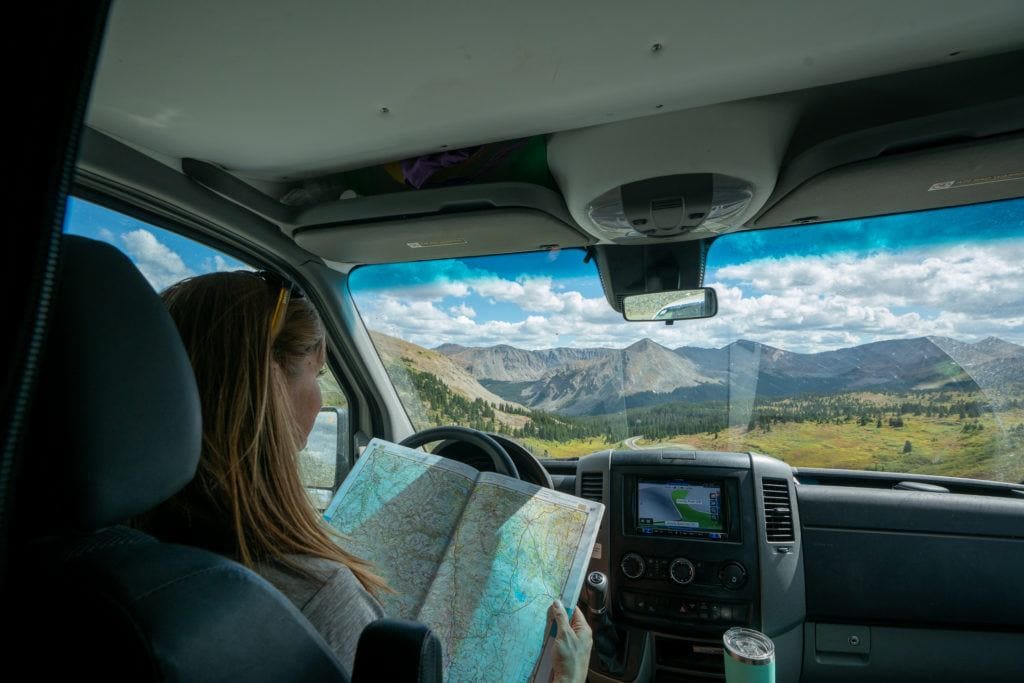
National Geographic Maps
These topographic maps are great for backpacking as they are waterproof and tear-resistant. They come location specific; for example Big Sur & the Ventana Wilderness. The maps provide detailed information about specific lands and ranger districts while also showing all National Forest boundaries. They also often point out roads for dispersed camping, hiking trails, potential water sources, dump stations, and campgrounds that offer showers. You can generally find a great selection of National Geographic Maps at REI.
Free Maps
Don’t want to fork over the money for paper maps? Stop by the ranger station when you arrive at your destination. Many of them provide free public maps that you can take with you. If not, almost all of them have a big map on the wall of their jurisdiction. Use your phone to take a picture of the area you are interested in.
Google Maps
If you know an area that allows free camping, I like to switch Google Maps to satellite view and zoom in on the area. Sometimes you’ll find some “hidden” campsites or at least get a better idea of what the camping areas look like before you drive out.
Other Options for Free Overnight Parking
Before we move on, I want to quickly talk about other types of free places to park overnight.
Parking Lots
Not necessarily what you had in mind for your next great adventure, but if you find yourself caught in town refueling on supplies and need a place to sleep for the night, it’s important to note that you can find free, legal places to camp in cities that aren’t just truck or rest stops (although these are a great option in a pinch!)
When crashing in these types of parking lots, you have to stay (meaning sleeping, cooking, and hanging out) inside your vehicle for the evening, but if you’re in a bind, it can be a good option. Some truck stops even offer laundry services and coin-operated showers. Make sure to check with management if you are unsure or have any questions–not all locations in all states allow overnight parking.
Certain big box stores allow overnight parking – but not all. Below we’ve listed out the most common businesses that allow sleeping in your RV/van/car overnight (no tent camping), but we always recommend calling ahead or going in to speak to the manager. As always, follow any posted signs.
- Walmart
- Cabela’s
- Cracker Barrel (most have dedicated overnight parking spots in the back)
- Camping World (sometimes have free water, dump stations, and electrical hook-ups)
- Planet Fitness/Anytime Fitness/24-Hour Fitness
- Lowe’s/Home Depot/Menards
- Costco/Sam’s Club
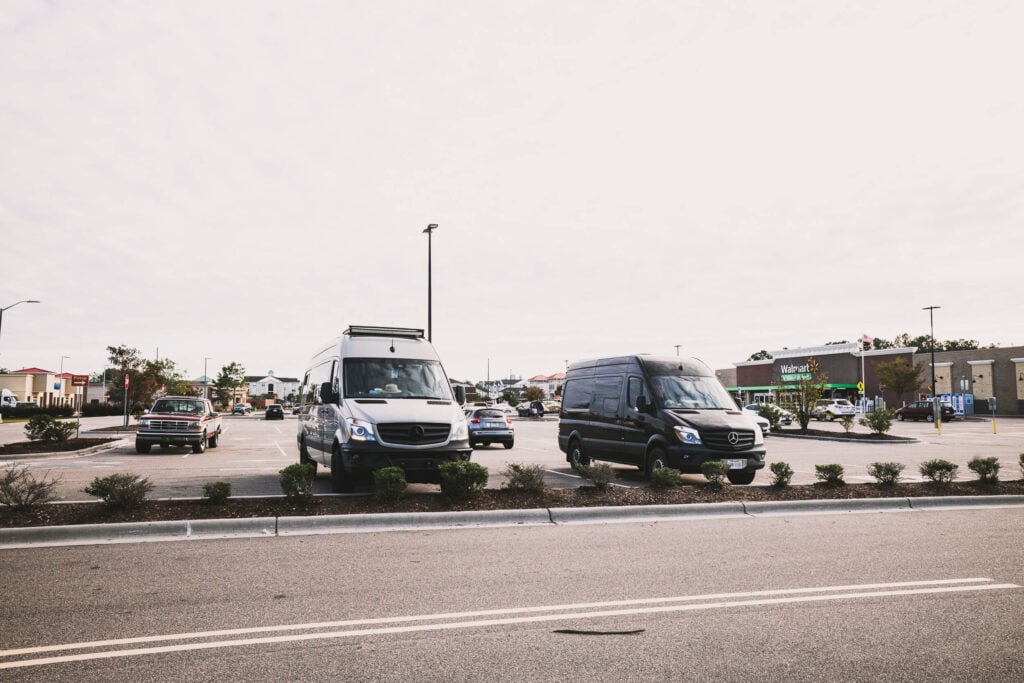
Casinos, Truck Stops, & Rest Stops
Casinos, truck stops, and rest stops also offer overnight parking. Usually, their parking lots are well lit (which is nice for safety), and some will have a dedicated area for big rigs and even shower facilities. These can be noisy depending on their proximity to the road and the coming and going of big rigs, but if you’re in a pinch or just need a convenient place to overnight, these are good options. For casinos with overnight parking, use the map locator on casinocamper.com to see which casinos allow overnight parking.
Harvest Hosts & Boondockers Welcome
Another great option is Harvest Hosts and Boondockers Welcome. An annual Harvest Hosts membership allows you to park overnight for free at a variety of wineries, breweries, farms, museums, golf courses, and other attractions. They do require you to be self-contained with a toilet, so keep that in mind. Use this link to get 30% off your first year with the code FRIENDS30. Purchasing something and supporting the small businesses you camp at is encouraged but not required.
Boondocker’s Welcome connects you with private property owners who welcome overnight campers. These are often in driveways, fields, or backyards and some allow multiple-night stays. You can add Boondockers Welcome to your Harvest Hosts plan for 30% off the first year as well. (Note: You also must be self-contained to use Boondocker’s Welcome).
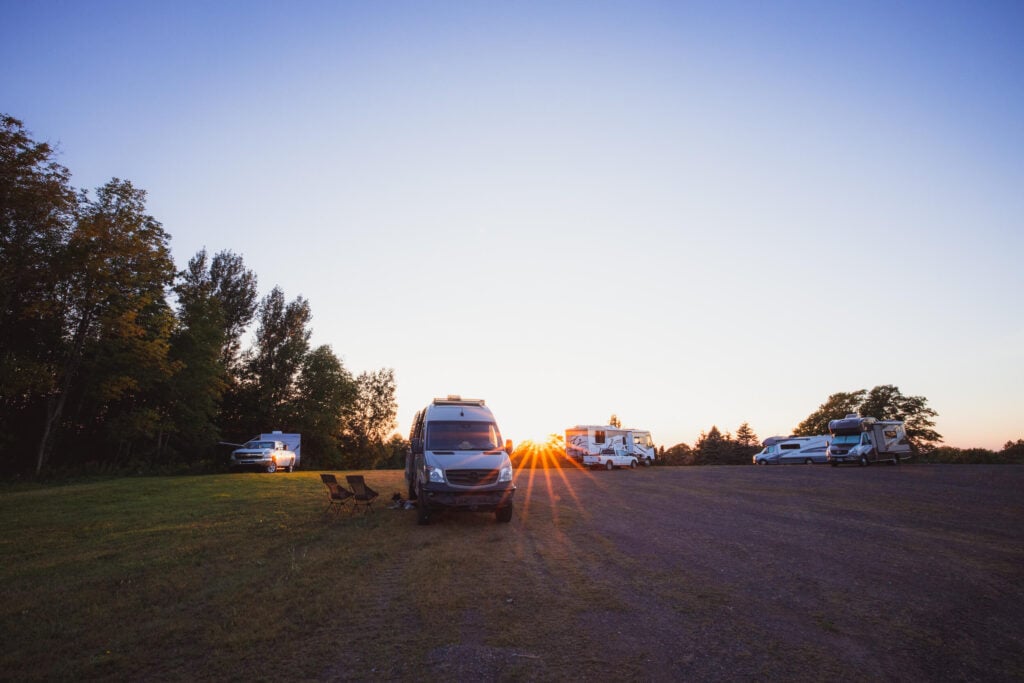
Important Things to Consider Before Free Camping
While free campgrounds certainly have their perks like solitude and saving money, there are some disadvantages as well. If you’re planning your first dispersed camping trip, it’s best to go in with the mindset that it is not going to be the same experience as a paid campground. Here are a few key things to keep in mind about dispersed camping:
- Fire Regulations: Dispersed free campsites may or may not have a fire ring so it is important you do your research to find out whether any fire restrictions are in place and to come prepared with basic backcountry fire safety skills. If you find a spot without a fire ring, it’s best practice to not create a new one. For more on backcountry fires, check out our guide to having a safe campfire.
- Road Conditions: Before heading out, you’ll want to find out what the road conditions are like, whether you need 4-wheel drive, and whether there are any road closures. Sometimes an app or map on your phone might not distinguish a paved road from a dirt one, and a graded maintained dirt road from a road that needs higher clearance and 4-wheel drive. Be sure to check the weather in advance too which can change road conditions.
- Water Availability: Will there be any water sources nearby and are they potable? You’ll want to know this so you can bring enough water if there’s none available or a water filter if needed, and also so you can make sure to camp 200 feet away from any stream or water source.
- Dump facilities: Unlike established campgrounds, dispersed campgrounds typically won’t have a dump station on-site or nearby. If you have a grey or black water tank, plan accordingly and make sure to look up the closest dump station for your trip.
- Campsite Amenities: Generally there are no amenities such as picnic tables, trash receptacles, sinks, electrical hookups, camp hosts, or restrooms at free dispersed campsites. Bring a trash bag and be prepared to pack out your trash, and if there aren’t restrooms, know how to go to the bathroom outdoors while abiding by Leave No Trace principles.
- Cell Service: A lot of dispersed free campsites are in remote areas where you may not have cell service to access maps on your phone. Be sure to let your loved ones know where you’ll be and we highly recommend carrying paper maps with you in your car which are also helpful for identifying nearby hiking trails and other recreation opportunities.
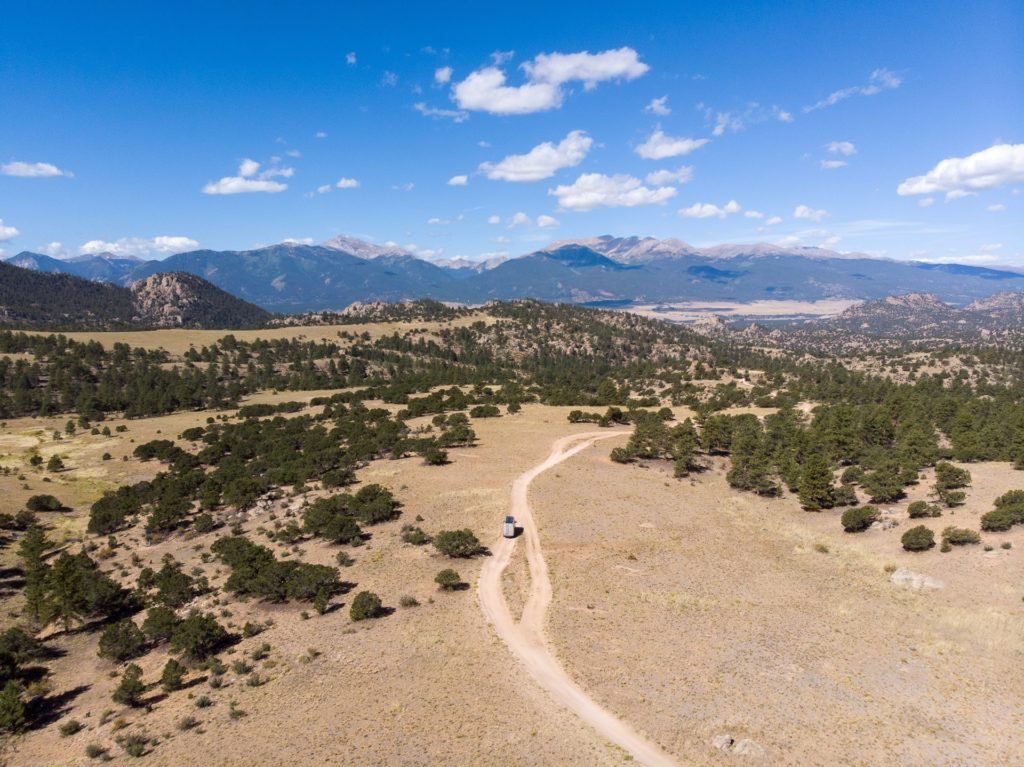
Tips for Finding Free Campsites
When you’re first starting out, finding free campsites might feel intimidating (I know it was for me). Here are some ways to ease into your first free camping trip:
- Finding a campsite is much easier when you are still in service. So, if you know the general region you want to stay in, do your research before you get out of cell range. Again, my preferred apps have some functionality offline, but you can plan with more certainty when you have a signal.
- Searching for campsites is easier and less stressful during daylight. If at all possible, try to be settled before it gets dark.
- Adopting a mindset that you don’t have to have a perfect camping setup every night will make finding campsites while on the road a lot easier. Some nights you might be in the forest with no view or you might be parked in a big open area near a lot of other campers. If you are camping only one weekend a year, a view and solitude might be super important to you, but if you’re road tripping or doing van life for an extended period of time, you’re going to be camping all the time. Some nights, you’ll hit the jackpot. Other nights, your campsites might be mediocre, and that’s ok. You can pack up in the morning and move on to somewhere better. All you really need is a flat spot with enough space, and the biggest thing is that you feel safe and you aren’t blatantly breaking the law.
- Ranger stations can be a great resource for information. If you are unsure about where you are allowed to camp, swing into the local ranger station for maps and advice.
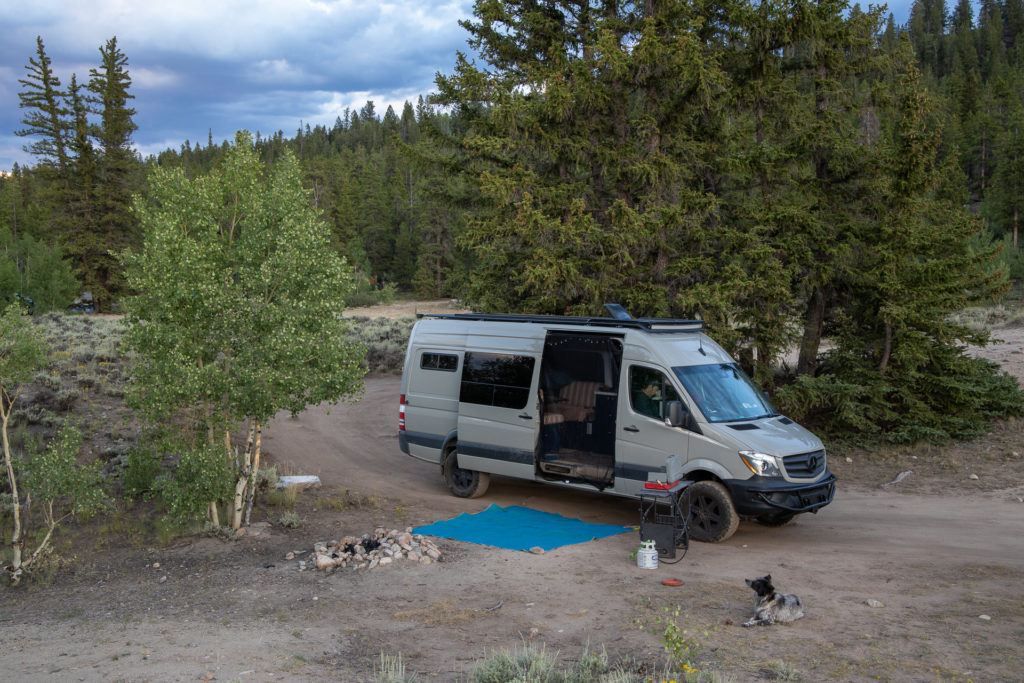
What To Pack For Free Camping
When dispersed camping, you’ll need to take into account the lack of amenities such as potable water, a picnic table, and showers. We recommend checking out our complete car camping checklist for the basics, and we’ve highlighted some of our essentials for free camping below:
- Portable water jug: depending on the length of your trip, you’ll want to pack a few of these (filled with water) so you can wash dishes, rinse off, and have drinking water.
- Folding table: you’ll want something to set your camp stove on to cook & a spot where you can play games, journal, etc. I love the GCI Slim-Fold Cook Station because it folds down flat and has tons of hooks for organizing your camp kitchen.
- Portable shower: if you plan to boondock for an extended period of time or want a way to rinse off, we recommend the NEMO Helio Pressure Shower or the Geyser Portable Shower w/ Heater.
- Safety items: including a portable car jumper, first aid kit, and tire patch kit
- Poop kit: a small shovel, toilet paper (pack it out!), hand sanitizer, and a small Ziploc for your used toilet paper
- Garbage bags: so you can easily pack out everything you bring in – there are no dumpsters on public lands!

Is Dispersed Camping Safe?
Taking extra safety precautions when you’re camping is an important consideration, especially when free camping when you may be far away from other people and without cell signal. Here are a few ways to keep safety top of mind:
- Trust your gut: If you have a bad feeling about a campsite, leave. Never second guess your instincts – you can always find another campsite.
- Be aware of your surroundings: Pay attention to who and what are around you. If you’re camping alone, consider finding a spot with other campers nearby.
- Download offline maps: Don’t put yourself in a position to get lost or stranded. Download maps ahead of time or grab a paper map as backup.
- Tell someone your plans: Let someone know where you plan to camp and when you expect to return. Check in often, especially if your plans change.
- Have an exit plan: Always keep the driver’s seat clear and have a designated spot for your keys. If possible, park where you can’t be blocked in and don’t need to reverse to get out of a spot.
- Keep your doors locked: Especially when you’re sleeping!
- Consider carrying a self-defense tool: Some people may feel safer if they carry pepper spray, a taser, etc.
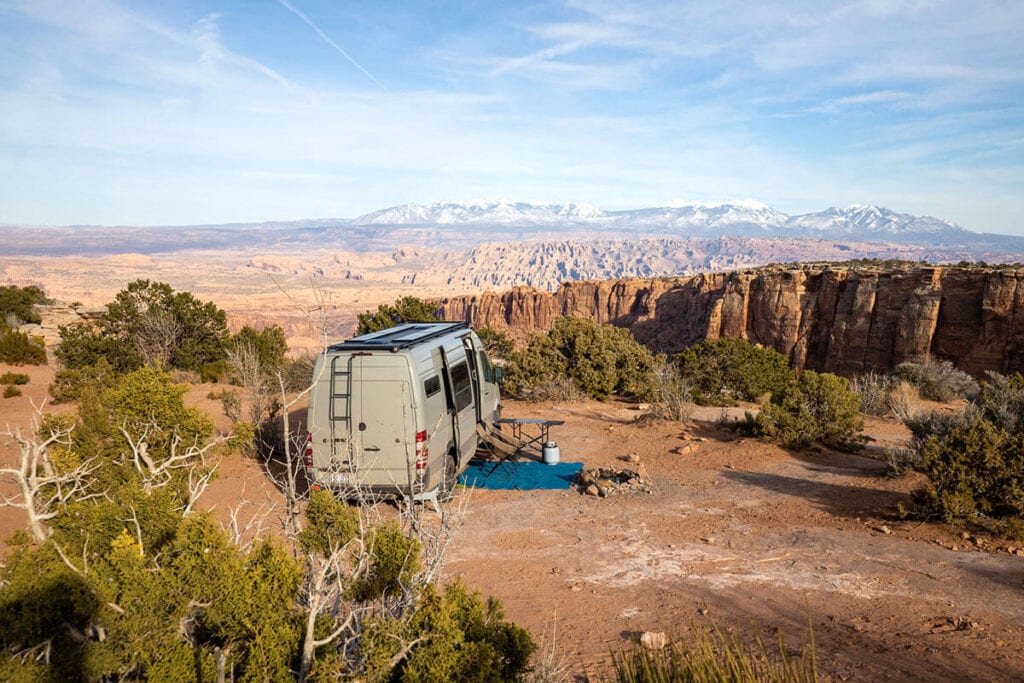
Leave No Trace & Dispersed Free Camping
One of the reasons you’ll enjoy dispersed camping so much is because of its lack of human presence. In reality, dispersed camping is camping at its finest -stunning backdrops and the brilliant night sky without the common distractions of our bustling world. Please follow Leave No Trace principles to ensure your favorite rugged locations stay wild for years to come. There are many public lands that are at risk of being shut down due to overuse and because campers are leaving behind trash, taking surface dumps and not packing out their toilet paper, and driving off-road to create new campsites. Here are a few ways we can ensure free camping stays free:
- Pack it in, pack it out: You need to take EVERYTHING with you when you leave a dispersed campsite, including your camping gear, trash, and personal items. Bonus if you pick up any trash that was left behind from previous campers.
- Know how to properly poop outdoors. This also extends to picking up your pet’s poop on public lands.
- Do not drive off-road or create new campsites in free camping areas. Stay on durable surfaces.
- Use already existing fire rings, do not make your own.
What questions do you have about how to find free campsites? Share your experiences and tips with boondocking, dispersed camping, and free camping in the comments below!


Great article! One additional resource that\\\’s awesome is the app Avenza PDF Maps. It\\\’s free, and you can get the USFS maps through this app in a much more convenient format than through the website. The PDF maps show forest roads and dispersed camping areas, and are georeferenced so you\\\’ll see exactly where you are on them. I highly recommend it for dispersed camping in National Forests and Grasslands.
Sweet. Thanks Steve! I’ll check that out.
I really enjoyed this read… Shared among some friends. In six years I’m retiring and living in Class A RV full time, much of this I did not even know was available but will now have this in the front of my mind so that we travel smart. Thanks So Much for all the information. xoxo from Indiana
Nice read. Thank you.
Thanks, this is a GREAT article, really appreciated it. Heading out in May, very timely
ioverlander helped me free camp across the US and Canada, it’s a pretty great free app. Canadian wild camping along the shore of the great lakes was incredible, you have to get up there! I’m so glad to have stumbled upon your site as I’m making a shift from car camping to backpacking. Such empowering content! Way to make adventure feel accessible 🙂 Thanks!
I enjoyed reading your article I got a lot of information I am learning about camping and about campsites and I found your information very helpful and useful thank you
Outstanding work.
Thank you so much for writing this comprehensive article! my husband and I have done most of our dispersed camping in AZ, we know the areas and back roads there. we recently moved to Nevada, I know most of the state is BLM land and probably fine to camp most places. But, we area 100% and having an app that doesnt need service to use the maps is amazingly helpful. 🙂
The free trial of TheDyrt Pro was such a brilliant and helpful find as I start planning my first big adventure. Thank you!
Hi Annie, we’re so glad you found The Dyrt Pro helpful! Hope you have a great time on your trip!
Please don’t try to fool people into believing wasp spray is good for defense. It is useless. It is mostly water with a few chemicals that that don’t sting or burn, even in the eyes. The perp may get cancer in 30 years. But that isn’t going to help them when they need it.
Thanks for letting us know! We’ve removed it from the post.
It is a good idea to travel with a satellite-based SOS device and subscription, such as Garmin InReach or Zoleo’s satellite communicator. When you do not have cell service, which many dispersed sites are lacking, you need to be able to contact someone for help in case of an emergency. The newer iPhones now have an SOS feature that might be all you need, but review the options and determine what would work best for you. Also recommend a portable power bank to recharge your phone or satellite communicator; a portable air compressor to fill up low tires; bear spray; and a portable car battery charger.
Hi Pat – yes I totally agree. I have a Garmin Inreach Mini that comes with me everywhere. In came in handy a couple years ago when we woke up to a dead van battery in sub 0 temps. I used it to text my dad who was able to arrange for someone to come help us. My partner Ryan is also type 1 diabetic, so it gives me peace of mind when we are hiking in case something were to ever go wrong. Thanks for sharing your thoughts! – Kristen